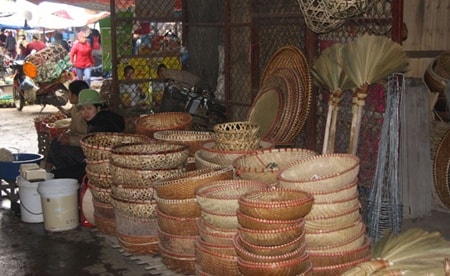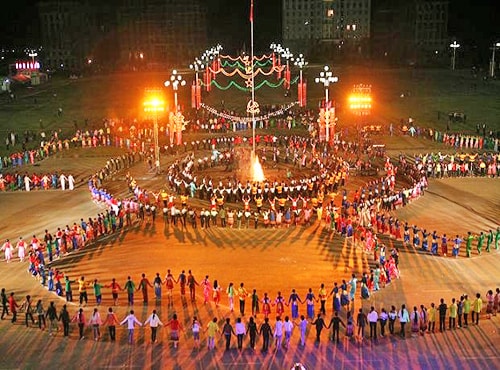Nghia Lo, with a population of 30,000, is tucked away in a big, flat valley called Muong Lo and offers a lot of experiences to tourists. It is second only to the Muong Thanh valley of Dien Bien Province in terms of size and is surrounded by unlimited chains of mountains.
Nghia Lo town offers visitors taste of highland life
|

|
|
Scenic: The view from a coach travelling along passes on
the slopes of hills in Nghia Lo town. — VNS Photos Tien Thanh
|
If you want to see the culture and daily life in Viet Nam's
mountainous but spectacular northwestern region, Nghia Lo town in Yen Bai
Province is a must-visit destination.
Nghia Lo, with a population of 30,000, is tucked away in a
big, flat valley called Muong Lo and offers a lot of experiences to tourists.
It is second only to the Muong Thanh valley of Dien Bien Province in terms of
size and is surrounded by unlimited chains of mountains.
Reaching the town is itself an exciting experience for
anyone who has never set foot in mountainous regions. Whether you take the
five-hour coach from Ha Noi or catch a train from Ha Noi to Yen Bai City, the
province's capital, and then take a three-hour coach ride, you will experience
one of the most unforgettable journeys of your life.
In my opinion, backpackers going to Nghia Lo by coach will
have the best opportunity to see the spectacular views of the region. There are
ticket booths, but you can also reach the My Dinh Coach Station, and board the
coach which displays Nghia Lo as its destination.
|

|
|
Rustic charm: A booth at the Muong Lo Market sells bamboo
wares.
|
Nghia Lo is just over 200km from Ha Noi but after half-way,
the coach winds through passes which zigzag through endless ranges of
mountains. With comfortable seats, most coaches look rather new and give you
sense of safety. So, the journey begins.
After passing through populous and urbanised towns in the
lowland areas, the coach goes through the mountain passes that are up to 1000m
above the sea level. Breathtaking views can be seen here.
Sometimes you see the mountain slopes, sometimes the valleys
far below, with scattered houses-on-stilts of ethnic minorities. At another
section, tea gardens and small streams come into view, an infinite green of
trees, bushes and fresh air.
After nearly three hours of feasting your eyes on gorgeous
views of a spellbinding nature, you arrive in a huge valley. Nghia Lo Town soon
draws your attention, with views of farmers working in paddy fields and vendors
on the sidewalk of the road leading to the town.
Being the second largest town in Yen Bai, Nghia Lo's centre
quarter is as bustling and vibrant as any other town in the Red River Delta,
northern Viet Nam's economic hub, if not more colourful. It is home to various
ethnic minorities and was once the biggest trading centre of the northwestern
region.
The first place to visit is the Muong Lo Market in the
centre of the town. It was once the biggest market in the whole northwestern
region and is now the commercial hub of Yen Bai's western region.

"Xoe" Big in Nghia Lo City
A person can buy almost everything he or she needs, such as
household goods, ready-made clothes and luxury kitchenware. The most
interesting item of the market, which either doesn't exist or is rarely seen in
markets in the lowland region, are booths where husbandry tools are piled up.
Strolling along the paths that cross each other like on a
chessboard, and much like a miniature version of the famous Dong Xuan Market in
Ha Noi, a person can buy hoes, hatchets and machetes, different kinds of
baskets and barbed wires for making fences.
"There are decent numbers of foreign tourists visiting
the market, most of them Germans and French," said the owner of a booth.
"Most of the tools and equipment used for farming that
can be found in the local market are produced by residents from around the
region," she said, refusing to give me her name.
"The market becomes even more colourful and vivid in
the days approaching Tet when people from all the ethnic groups flock to the
town to exchange and trade goods for the year's most important festival,"
said Nguyen Van Luyen, a local resident.
While the Muong Lo Market sells goods for households and
farming, a few hundred metres away down the street is another vibrant market of
the same size, selling food, specialties and flowers.
After enjoying a leisurely stroll around the two markets and
picking up some local products such as tho cam, a kind of brocade cloth which
you can give as a souvenir or gift to your loved ones, it's time to fill your
empty stomach with a meal of extremely delicious and cheap organic pig meat, or
com lam which is rice cooked in tubes of bamboo or five-colour sticky rice.
In the afternoon, you can rent a motorbike to visit hamlets
on the fringes of the town, where a majority of the ethnic minority lives in
houses on stilts and grows rice. You can learn about the daily farming
activities in paddy fields and the small businesses of local people.
If you visit the Deu hamlet on the first few days of the
Lunar New Year, you will have a great opportunity to witness or participate in
the Mua Xoe, a unique dance of the Thai ethnic minority. It is performed on a
large concrete ground by hundreds of dancers. It's also the right time to enjoy
the beauty of Ban, a type of flower in the northwestern region.
Situated a few kilometres from the centre of the town is a
hot spring, the water of which is believed to cure arthritis. The spring's warm
water allows people to apply it directly. However, the water is still being
used by the local people only and has not been tapped for its health benefits
yet.
"Many old people in the valley come here to bathe every
few days. The water is very good for the health and skin. A person feels as
fresh as a daisy and has healthy white skin after they've bathed in the spring
water," Pham Tan Hoa said.
"Bathing regularly in the stream for a period of time
can cure arthritis for the whole year," Hoa claimed.
From Nghia Lo, you can also visit Suoi Giang, about 12km
away, and see the old tea trees which are hundreds of years old.
After taking in everything in Nghia Lo, you can return to Ha
Noi or continue your adventure with a long trip through the extraordinary Khau
Pha pass further north to visit Mu Cang Chai, 100km away. It has a
nationally-recognised vast area of terraced paddy fields. Or you can go to the
famous tourist destination Sa Pa, which is around 200km further north. — VNS.